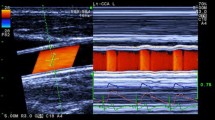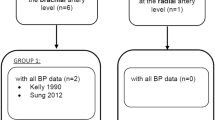Abstract
Purpose
This research focuses on developing new ways to monitor coronary artery disease (CAD), the leading type of cardiovascular disease, which requires more straightforward, safer, and more continuous tracking methods along with angiography, the gold standard method. This need arises due to the high risk, cost, and the large number of people living with undiagnosed CAD. The study explores the use of the intrinsic frequency (IF) method, a promising but underutilized technique in the realm of CAD monitoring, to investigate its effectiveness in identifying CAD through the analysis of radial pressure wave patterns.
Method
The radial pressure waves, alongside major CAD risk factors (hypertension, diabetes, hyperlipidemia, smoking, family history, age, and sex) were analyzed in 100 patients undergoing angiography. The IF method was utilized to evaluate the dynamics of heart and arterial system function, focusing on specific IF indices that reflect vasculature health level.
Result
The results, validated through T-tests, reveal notable alterations in specific IF indices among CAD patients: \({{\varvec{\omega}}}_{2}\) shows a significant increase with a mean of 82.5 bpm in CAD versus 41.56 bpm in non-CAD cases. Similarly, \({\varvec{\Delta}}{\varvec{\omega}}\) displays a significant decrease with a mean of 15.73 bpm in CAD compared to 49.02 bpm in non-CAD individuals. Conversely, \({{\varvec{\omega}}}_{1}\) demonstrates minimal variance between CAD and non-CAD groups.
Conclusion
This study underscores the potential of IF indices, particularly \({{\varvec{\omega}}}_{2}\) and \({\varvec{\Delta}}{\varvec{\omega}}\), as markers for severe CAD cases and strongly advocate for the integration of continuous monitoring strategies via modern technology in healthcare, such as smartwatches in CAD management.
Graphical Abstract





Similar content being viewed by others
Data availability
The Radial pressure wave data that support the findings of this study are available in Zenodo with the identifier. https://zenodo.org/doi/10.5281/zenodo.11011983
References
Virani, S. S., et al. (2020). Heart disease and stroke statistics—2020 update: A report from the American Heart Association. Circulation, 141(9), E139–E596. https://doi.org/10.1161/CIR.0000000000000757
Khan, M. A., et al. (2020). Global epidemiology of ischemic heart disease: Results from the Global Burden of Disease Study. Cureus, 388, 539–547. https://doi.org/10.7759/cureus.9349
Jiangping, S., et al. (2013). Assessment of coronary artery stenosis by coronary angiography. Circulation: Cardiovascular Interventions, 6(3), 262–268. https://doi.org/10.1161/CIRCINTERVENTIONS.112.000205
Gersh, B. J. (2011). Low diagnostic yield of elective coronary angiography. Yearbook of Cardiology, 2011, 262–263. https://doi.org/10.1016/j.ycar.2011.01.014
Avolio, A. P., Butlin, M., & Walsh, A. (2010). Arterial blood pressure measurement and pulse wave analysis-their role in enhancing cardiovascular assessment. Physiological Measurement. https://doi.org/10.1088/0967-3334/31/1/R01
Mynard, J. P., Kondiboyina, A., Kowalski, R., Cheung, M. M. H., & Smolich, J. J. (2020). Measurement, analysis and interpretation of pressure/flow waves in blood vessels. Frontiers in Physiology, 11(August), 1–26. https://doi.org/10.3389/fphys.2020.01085
Zhang, C., et al. (2021). Identifying coronary artery lesions by feature analysis of radial pulse wave: A case–control study. BioMed Research International, 2021, 1–8. https://doi.org/10.1155/2021/5047501
Cooper, L. L., et al. (2021). Intrinsic frequencies of carotid pressure waveforms predict heart failure events: The Framingham Heart Study. Hypertension, 77(February), 338–346. https://doi.org/10.1161/HYPERTENSIONAHA.120.15632
Tavallali, P., Hou, T. Y., Rinderknecht, D. G., & Pahlevan, N. M. (2015). On the convergence and accuracy of the cardiovascular intrinsic frequency method. Royal Society Open Science. https://doi.org/10.1098/rsos.150475
Pahlevan, N. M., et al. (2014). Intrinsic frequency for a systems approach to haemodynamic waveform analysis with clinical applications. Journal of The Royal Society Interface. https://doi.org/10.1098/rsif.2014.0617
Latif, M. A., et al. (2016). Volumetric single-beat coronary computed tomography angiography: Relationship of image quality, heart rate, and body mass index. Initial patient experience with a new computed tomography scanner. Journal of Computer Assisted Tomography, 40(5), 763–772. https://doi.org/10.1097/RCT.0000000000000428
Tavallali, P., Koorehdavoudi, H., & Krupa, J. (2018). Intrinsic frequency analysis and fast algorithms. Scientific Reports, 8(1), 1–14. https://doi.org/10.1038/s41598-018-22907-4
Mogadam, E., et al. (2020). Intrinsic frequency method for instantaneous assessment of left ventricular-arterial coupling after transcatheter aortic valve replacement. Physiological Measurement, 41(8), 085002. https://doi.org/10.1088/1361-6579/aba67f
Pahlevan, N. M., Dai, W., & Kloner, R. A. (2018). Noninvasive and instantaneous diagnostics of acute myocardial infarction using intrinsic frequency method. Circulation, 138, A15311–A15311. https://doi.org/10.1161/circ.138.suppl_1.15311
King, E., Cobbin, D. M., Walsh, S., & Ryan, D. (2002). The reliable measurement of radial pulse characteristics. Acupuncture in Medicine, 20(4), 150–159. https://doi.org/10.1136/aim.20.4.150
Nichols, W. W., O’Rourke, M. F., Vlachopoulos, C., Hoeks, A. P., & Reneman, R. S. (2011). McDonald’s blood flow in arteries theoretical, experimental and clinical principles. Echocardiography, 8, 1–742. https://doi.org/10.1111/j.1540-8175.1991.tb01207.x
De Melis, M., et al. (2009). Blood pressure waveform analysis by means of wavelet transform. Medical & Biological Engineering & Computing, 47(2), 165–173. https://doi.org/10.1007/s11517-008-0397-9
Parker, K. H., & Jones, C. J. H. (1990). Forward and backward running waves in the arteries: Analysis using the method of characteristics. Journal of Biomechanical Engineering, 112(3), 322–326. https://doi.org/10.1115/1.2891191
Hughes, A. D., & Parker, K. H. (2009). Forward and backward waves in the arterial system: Impedance or wave intensity analysis? Medical & Biological Engineering & Computing, 47(2), 207–210. https://doi.org/10.1007/s11517-009-0444-1
Cooper, L. L., et al. (2021). Intrinsic frequencies of carotid pressure waveforms predict heart failure events: The Framingham Heart Study. Hypertension. https://doi.org/10.1161/HYPERTENSIONAHA.120.15632
Gatzka, C. D., Cameron, J. D., Kingwell, B. A., & Dart, A. M. (1998). Relation between coronary artery disease, aortic stiffness, and left ventricular structure in a population sample. Hypertension, 32(3), 575–578. https://doi.org/10.1161/01.HYP.32.3.575
Mogadam, E., Shavelle, D., Liu, J., Giesler, G., Matthews, R., & Pahlevan, N. (2020). Validation of a non-invasive approach for the assessment of left ventricular-arterial coupling following transcatheter aortic valve replacement. Circulation, 142, A16138–A16138. https://doi.org/10.1161/circ.142.suppl_3.16138
Acknowledgements
The authors would like to acknowledge gratefully all patients and staffs of Rajaiee heart Hospital, Tehran, Iran.
Funding
The authors declare that no funds, grants, or other support were received during the preparation of this manuscript.
Author information
Authors and Affiliations
Contributions
All authors contributed to the study conception and design. Material preparation, data collection and analysis were performed by Anooshirvan Mahdavian, Ali Fahim, Reza Arefizadeh, and Seyyed Hossein Mousavi. The first draft of the manuscript was written by Anooshirvan Mahdavian and all authors commented on previous versions of the manuscript. All authors read and approved the final manuscript.
Corresponding author
Ethics declarations
Competing Interests
The authors have no relevant financial or non-financial interests to disclose.
Supplementary Information
Below is the link to the electronic supplementary material. Also the Data of Radial Pressure wave are available in Zenodo with the identifier https://zenodo.org/doi/10.5281/zenodo.11011983.
Rights and permissions
Springer Nature or its licensor (e.g. a society or other partner) holds exclusive rights to this article under a publishing agreement with the author(s) or other rightsholder(s); author self-archiving of the accepted manuscript version of this article is solely governed by the terms of such publishing agreement and applicable law.
About this article
Cite this article
Mahdavian, A., Fahim, A., Arefizadeh, R. et al. The Effect of Coronary Atherosclerosis on Radial Pressure Wave: A Cross-Sectional Observational Clinical Study. J. Med. Biol. Eng. 44, 181–190 (2024). https://doi.org/10.1007/s40846-024-00867-7
Received:
Accepted:
Published:
Issue Date:
DOI: https://doi.org/10.1007/s40846-024-00867-7




